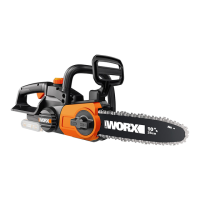21
Cordless Chain Saw
EN
with proper tension.
How to use Saw Safely
1. Use the chain saw only with secure footing.
2. Hold the chain saw at the right-hand side of your
body (See Fig. L).
3. The Chain (7) must be running at full speed before
it makes contact with the wood.
4. Use the Bumper Spikes (13) to secure the saw
onto the wood before starting to cut.
5. Use the Bumper Spikes as a leverage point while
cutting. (See Fig. M)
6. Do not operate the chain saw with arms fully
extended, attempt to saw areas which are difficult
to reach, or stand on a ladder while sawing (see
Fig. N).
Never use the chain saw above shoulder height
CUTTING WOOD UNDER TENSION (See fig. O)
WARNING: When cutting a limb that is
under tension, use extreme caution. Be
alert for wood springing back. When wood
tension is released, limb could spring back and
strike operator causing severe injury or death.
When sawing logs supported on both ends, start
the cut from above(Y) about 1/3 of the diameter into
the log (overbuck) and then finish the cut (Z) from
below, in order to avoid contact of the chain saw with
the ground. When sawing logs supported on only
one end, start the cut from below (Y) about 1/3 of
the diameter into the log (underbuck) and finish the
cut from above (Z) in order to avoid log splitting or
jamming of the chain saw.
OPERATION FOR POLE SAW (ONLY FOR
WG323E, WG323E.9)
Cutting with shoulder strap (See Fig. P1)
The extension pole is supplied with a shoulder strap
that gives extra support when hoisting the Pole Saw
in the air. Hook the shoulder strap to the extension
pole and wrap around your shoulder. The shoulder
strap can also soften the impact if the Pole Saw is
dropped after the completion of a cut.
Cutting with extension pole
1. Install the battery pack into the machine.
2. Before cutting a high branch, consider all the same
points detailed in the previous section “Trimming
Branches” but pay particular attention to the likely
path of the falling branch.
WARNING: Do not stand directly below a
branch being cut. Keep bystanders far
away. Do not stand on a ladder or other type of
unstable support while using the tool. Do not
use the tool near cable, electrical power or
telephone lines. Keep 3m(10 ft) away from all
power lines. (See Fig. P2-P5)
3. Use both hands to grip Pole Saw. Use only
designated grip areas when operating Pole Saw
(See Fig. P6). Use firm grip. Thumbs and fingers
must wrap around Pole Saw handle and pole.
4. Make sure your footing is firm. Keep feet apart.
Divide your weight evenly on both feet.
5. When ready to make a cut, press the Lock-out
Button (30), then fully press the On/off Switch (31)
(See Fig. P7). This will turn Pole Saw on. Releasing
On/off Switch will turn Pole Saw off. Make sure
saw is running at full speed before starting a cut.
6. When starting a cut, place moving chain
against wood. Hold Pole Saw firmly in place to
avoid possible bouncing or skating (sideways
movement) of saw.
7. Guide Pole Saw using light pressure. Do not force
Pole Saw. The motor will overload and can burn
out. It will do the job better and safer at the rate for
which it was intended.
8. Remove Pole Saw from a cut with saw running
at full speed. Stop Pole Saw by releasing trigger.
Make sure chain has stopped before setting Pole
Saw down.
TRIMMING A TREE (PRUNING)
WARNING: Avoid kickback. Kickback can
result in severe injury or death.
See Kickback, to avoid risk of kickback.
WARNING: Do not operate Pole Saw while
• in a tree
• on a ladder or any other unstable surface
• in any awkward position
You may lose control of Pole Saw causing
severe injury.
WARNING: Do not extend arms above
shoulders when using Pole Saw.
CAUTION: Seek professional help if facing
conditions beyond your ability.
Trimming a tree is the process of cutting limbs from a
living tree. Make sure your footing is firm. Keep feet
apart. Divide your weight evenly on both feet.
Follow directions below to trim a tree.
1. Make first cut 15cm from tree trunk on underside
of limb. Use top of guide bar to make this cut. Cut
1/3 through diameter of limb (See Fig. P8).
2. Move 5 to 10cm farther out on limb. Make second
cut from above limb. Continue cut until you cut
limb off.
3. Make third cut as close to tree trunk as possible
on underside of limb stub. Use top of guide bar to
make this cut. Cut 1/3 through diameter of stub.
4. Make fourth cut directly above third cut. Cut down
to meet third cut. This will remove limb stub.
SAW MAINTENANCE
Follow maintenance instructions in this manual.
Proper cleaning of saw and chain and Guide Bar
maintenance can reduce chances of kickback. Inspect
and maintain saw after each use. This will increase the
service life of your saw.
NOTE: Even with proper sharpening, risk of kickback
can increase with each sharpening.

